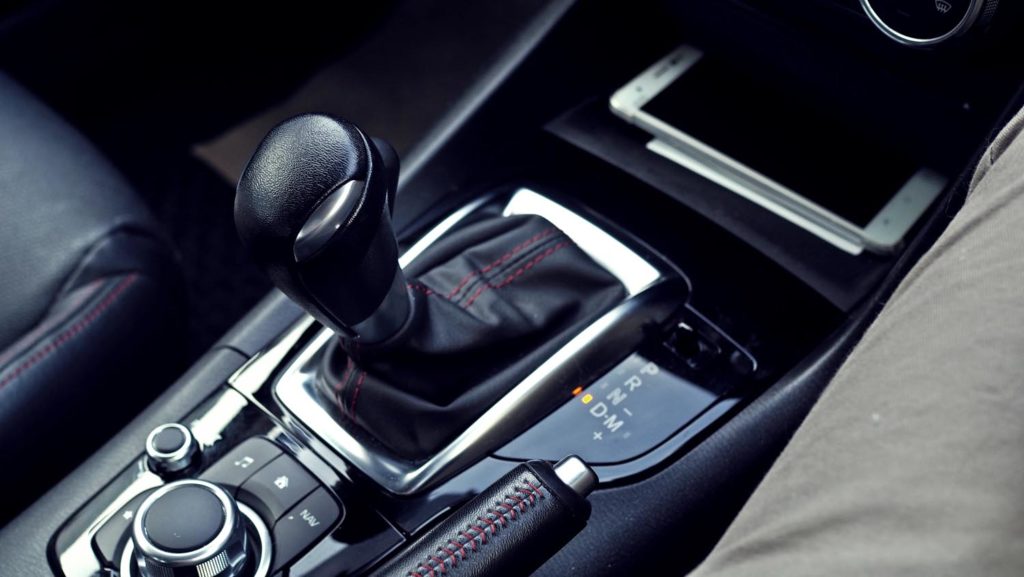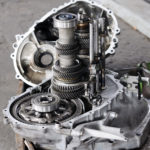Whether you’re in the market for a new or used vehicle, the factors to consider before buying either one are just the same一horsepower, drivetrain, miles per gallon (MPG), torque, engine displacement, etc. One of the most important things you should know about the vehicle is what kind of transmission it is equipped with. Familiarizing yourself with the transmission type and how to maintain it can help you avoid issues down the road.
Types of Transmission

Before we discuss the different types of transmissions, let’s first talk about what a transmission is and what it does. A vehicle’s transmission (regardless of the type) manipulates power from the engine and transfers that power to the drivetrain and wheels. It adjusts the gear ratio between the drive wheels and engine depending on the vehicle’s speed.
There are four common car transmission types一manual, automatic, continuously variable transmission (CVT), and dual-clutch.
Manual
Manual transmission is the simplest and oldest type of transmission. Also referred to as the stick shift or standard transmission, it uses a clutch that allows the driver to disengage the engine from the transmission to shift gears.

Torque flow through a manual transmission occurs when the clutch is engaged (clutch pedal up). Stepping on the pedal temporarily disengages the torque flow from the engine to the transmission for proper gear shifting.
Despite being an “endangered species” in today’s vehicles, a manual transmission has many advantages over modern gearboxes. It’s the easiest and cheapest type to repair, thanks to its simplicity.
A subjective perk of having a vehicle with a manual transmission is the driving experience. Many driving enthusiasts enjoy having total control over the drivetrain and the feeling of shifting their gears.
Automatic

The automatic transmission is arguably the most popular gearbox type today. It allows drivers to shift gears by applying clutches or bands to drive two or more planetary gear sets automatically. A typical automatic transmission has eight gear selector positions: park, reverse, neutral, overdrive, drive, third, second, and first position.
The automatic transmission offers a simplified driving experience, providing a gentle learning curve for new drivers. But the trade-off is that it is more complex than the manual type. As a result, it’s more prone to failure and costs more to fix or replace.
Continuously Variable Transmission (CVT)

CVTs are typically found in front-wheel-drive (FWD) or all-wheel drive vehicles with a transaxle. The design uses two variable-width pulleys to change the gear ratio, allowing the engine to operate in a speed range where it is most efficient.
Vehicles with a CVT are operated the same way as those with an automatic transmission but the transmission does not shift gears. Because of this, a CVT vehicle produces constant engine speed, which offers better fuel economy than an automatic transmission and reduces exhaust emissions. However, periods of rapid acceleration may create unusual noises and excessive vibration. These are uncommon in other transmission types.
Dual-Clutch
Unlike the conventional automatic transmission, semi-automatic and dual-clutch transmissions don’t use a torque converter and planetary gear sets. Instead, they use a manual type transmission and two concentrically mounted clutches to engage the main input or counter shaft.

These transmissions have a large clutch that drives odd-numbered gears and a small clutch that drives the even-numbered gears. Shifting gears with these transmissions won’t interrupt the torque from the engine, resulting in a rapid shift without the slight delay found on automatic transmission vehicles.
Semi-automatic and dual-clutch transmissions have several advantages over an automatic transmission. It offers a quicker throttle response, better fuel economy, and smoother operation than an automatic transmission. And because it uses components from a manual transmission, repair costs are often lower compared to an automatic gearbox.
Common Causes of Transmission Failure

Although the transmission is typically built to last as long as your vehicle’s service life, it can still fail prematurely due to several reasons.
Low Transmission Fluid
Driving your vehicle while it’s low on transmission fluid can lead to a loss of lubrication and pressure, resulting in damage to internal components.
Using the Wrong Transmission Fluid
Your vehicle requires transmission fluid with a specific set of additives and properties to keep it performing as it should. Using the wrong fluid can lead to poor lubrication and damage to the transmission. Make sure to consult your owner’s manual to know what type of transmission fluid your vehicle needs.

Excessive Towing
Towing beyond your vehicle’s capacity puts too much strain on the transmission, which may cause it to overheat.
Shifting While the Vehicle Is In Motion
For automatic transmission vehicles, shifting gears while still in motion may cause the gears’ teeth to grind, resulting in a damaged transmission, suspension system, and driveshaft.
Caring for Your Transmission
There’s no better way to prevent transmission failure than by sticking to your vehicle’s maintenance schedule. A transmission service involves flushing out the contaminated transmission fluid and replacing it with a new one to maintain your vehicle’s optimal performance. Routine maintenance also lets you know about the other issues your ride may have, so you can prevent them from getting worse.
Where To Get Transmission Fluid for Your Vehicle
Do you know how expensive it is to repair transmission failure? The final price varies depending on your vehicle’s year, make, and model, but we can guarantee it’s much more expensive than transmission fluid. Save yourself from costly repair bills by getting brand-new transmission fluid from CarParts.com today.
CarParts.com offers a wide selection of high-quality transmission fluid at different price points, so you’re sure to find one that best suits your car. Our vehicle selector also makes browsing easier. All you have to do is input your vehicle’s year, make, and model, and you’ll easily find the products that are compatible with your car. If you’re itching to get back on the road, you’ll be happy to know CarParts.com guarantees fast shipping. Order by 12 p.m., and you can expect your new transmission fluid to arrive in as fast as two business days.
Don’t wait for your gearbox to fail before replacing your transmission fluid. Check out our catalog of automatic and manual transmission fluid at CarParts.com today.
Any information provided on this Website is for informational purposes only and is not intended to replace consultation with a professional mechanic. The accuracy and timeliness of the information may change from the time of publication.

























